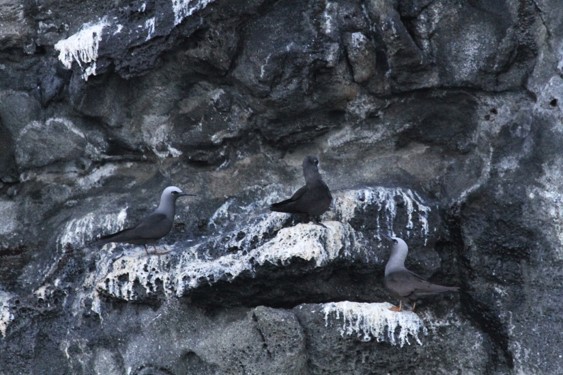(Anous minutus)
Hawaiian Name: Noio

The more common of the two species of Noddy in the Southeastern Hawaiian Islands, a breeding population of about 2,000 pairs of Black Noddies can be found breeding on all of the main islands, where they are restricted to nesting on rocky sea cliffs and offshore islets. About 15,000 pairs are found beeding amongst all of the island groups in the Northwestern Hawaiian Islands. Black Noddy is found worldwide in tropical oceans, but is most abundant in the central and southwestern Pacific Ocean.
In Kauaʻi, the Black Noddy is found breeding year round, as in the rest of the Hawaiian Islands, and can be seen from shore, usually en route to or from the main breeding colonies on the Na Pali Coast and Lehua Islet, where they nest in sea caves and cliffs. These movements of Black Noddies are easiest to see in in the Kekaha/PMRF/Polihale area on the west side and Keʻe Beach on the north shore. The Black Noddy does not range far out to sea and are most common within 80km of shore. This is another species that habitually follows schools of tuna, and is often found in mixed flocks with shearwaters, boobies, and Brown Noddies over feeding schools of fish, where it feeds by dipping down to the surface of the ocean and picking up small fish and squid brought to the surface by larger fish.
Breeding habits are similar to Brown Noddy, but breed much more readily on sea cliffs, and so are more common on the Southeastern Hawaiian Islands than Brown Noddy.

Two distinctive subspecies of Black Noddy occur in Hawaiʻi, with the widespread Pacific subpspecies A. m. marcusi breeding on the Northwestern Hawaiian Islands, and the Hawaiian endemic A. m. melanogenys found exclusively on the Southeastern Hawaiian Islands. The two subspecies co-occur on Kaʻula Rock and Lehua Islet and possibly on Nihoa and Necker. Both subspecies can be distinguished from Brown Noddy by their smaller size, overall black coloration with no contrast between the flight feathers and covert feathers on the wing, and the smaller and thinner bill. The endemic Hawaiian Black Noddy (A. m. melanogenys) is particularly easy to identify due to its contrasting pale gray tail and bright orange feet. Birds in the Northwestern Hawaiian Islands (A. m. marcusi) have dark feet and tails more similar to Brown Noddy and should be identified by the characters outlined above.
